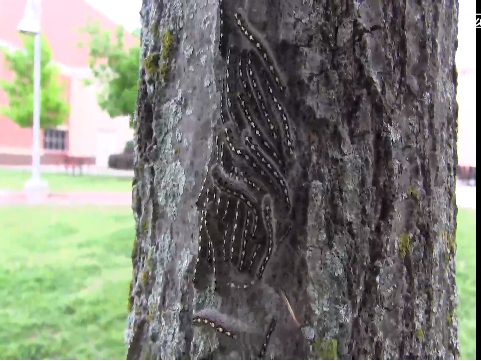The rise and fall of caterpillars in the courtyard

Just weeks ago, the courtyard was filled with caterpillars and life as they occupied the trees. Now, after spraying pesticide, all the caterpillars are dead.
April 24, 2015
Some new residents made a temporary home in the courtyard trees, and it was not birds or squirrels as one might suspect. Actually, it was quite the opposite of adorable, furry, woodland creatures. Several large clumps of caterpillars overtook the trees, and they seemed to not be harming the vegetation at first. But, they were recently killed due to the fact that they were, in fact, causing damage to the trees.
“If untreated, they can kill a tree by defoliation and they move to the turf where they can spread and do damage to the grass,” director of transportation Jerry Graham said. “They were treated with an insecticide over the weekend they were reported.”
The caterpillars were assumed to be tent caterpillars, and they are also known as tree worms, web worms, and bag worms. These caterpillars do not morph into butterflies. Instead, they transform into moths.
Tent caterpillars are currently causing major problems in East Texas, as they swarm up on things like sources of electrical power, causing power outages. These caterpillars have been seen before by many, but never in such a gathering.
“Why we haven’t seen them in previous years, another mystery. But, everything has cycles,” biology teacher Julie Johnston said. “Maybe the trees weren’t mature enough, maybe the worms were here but they weren’t in greater numbers and now they’re in great enough numbers. It could just be that this was finally the season and cycle for them to show up.”
Another problem the caterpillars caused was curiosity and disgust from students. They gave some people the creeps, but some were against harming them.
“I think they’re pretty gross, but they aren’t hurting anybody, so nothing should be done to remove them. It’s not a big deal unless you make it a big deal,” freshman KelsieAnn Trank said before news spread that they were killed. After she heard of their termination, she said, “I think there were more logical ways to approach the situation, such as simply moving them off campus. I don’t think killing them was the best option, but if it was the only possible way to save the trees, then I guess it just had to be done.”




